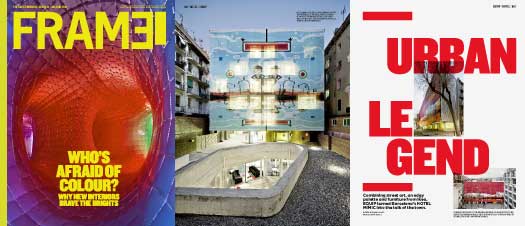Magazine
Frame
HOTEL ACTA MIMIC
Netherland
URBAN LEGEND
Combining street art, an edgy palette and furniture from Ikea, EQUIP turned Barcelona’s HOTEL MIMIC into the talk of the town.
Colour, claims Spanish designer Xavier Claramunt, is an excellent way to conceal cheap workmanship. He makes this honest observation in the lounge of the Hotel Mimic, one of the more talked-about new arrivals on Barcelona’s already eclectic hotel scene. Claramunt has described the building – a reflection of this part of the city’s hipster vibe – as ‘outrageous’ and ‘exhibitionist’.
As we talk, we are surrounded by a palette that would make the modern minimalist run a mile – in the opposite direction. Beneath a cheerful sky-blue ceiling, letterbox-red dining chairs and burnt-orange sofas have been arranged rather casually into meeting areas defined by candy-striped rugs. Neutrality pops up in the form of polished concrete columns and, in the breakfast area, tables and chairs made of wood. The columns support a series of arresting faux-Roman, pond-shaped skylights, which bathe the space in radiant Mediterranean light. Most of the furniture and accessories, however, looks as if it has been cleverly sourced from an Ikea catalogue. Without hesitation, Claramunt admits to having done just that.
Xavier Claramunt is well known in this city’s design scene for his unconventional approach. He’s part of the group that kick-started Barcelona’s current design fervour: the joyous, quirky and, yes, colourful style that took hold in the ‘new Barcelona’ of the early 1990s. Tellingly, he works out of Palo Alto, a converted textile factory that is considered the epicentre of the movement. (Palo Alto was founded by internationally renowned graphic designer and illustrator Javier Mariscal.) Equip, Claramunt’s studio, specializes in jewellery, industrial design, interiors and architecture. The outfit has made headlines of late for its involvement in the first space hotel, an earth-orbiting ‘satellite suite’ that is due to start operating in 2012.
Hotels have formed a large part of Equip’s cache. In fact, the Mimic was supposed to be the next branch of a chic boutique-hotel chain that numbers among the firm’s regular clients. When funding ran out, the project was acquired by the mid-range Acta Group and the brief changed, affording Claramunt the opportunity to create a hotel free of the constraints imposed by an established brand.
The Mimic is located near the port, in the Raval, a neighbourhood notable for its edgy street life and an area that’s managed to escape the more insalubrious elements of the barri by being situated behind the Drassanes (the city’s magnificent Gothic shipyards – now a museum) on a street that has been bulldozed to make way for new construction and a public square, a regular occurrence in this part of town. On the downside, however, the hotel occupies a long, narrow-ish site that borders, at the rear, a motley array of ancient, crumbling façades, balconies and clotheslines: a fascinating portrayal of inner-city life, perhaps, but also an urban eyesore.
Claramunt left the façade of the original building (the old Colon Theatre, which had been closed for many years) partially intact, more for the sake of sentimentality than for any aesthetic considerations. Guests approaching the hotel – a dynamic, playful building – catch sight of a gigantic polyester screen featuring a mural by Héctor Francesch, a local artist whose work exemplifies the buoyant street-art culture that abounds in the Raval. The main entrance is linked directly to a patio, where another of Francesch’s striking works, enlivened by strange creatures and urban symbols, covers the hotel’s rear façade. A spiral staircase on one side of the entrance area lends access to a lower-level lounge; on the other side, guests find a small reception area, where Salvador Dalí’s iconic, scarlet-red Lips sofa pouts suggestively by the lifts.
Rooms at the Mimic have been arranged like ‘shelves’ lining black corridors. These rooms emanate the sort of muted minimalism that has become standard fare in the more affordable design hotels, where a simple bed wrapped in white cotton sheets offers guests a place to relax while watching a large flatscreen TV high on the wall – and that’s about it. Loos are not part of the bedroom area, but the bathroom is. You can draw a translucent curtain next to the bed for a bit of privacy or leave the curtain open to create a greater sense of spaciousness.
Light filtering into the rooms through the exterior screen is the project’s greatest asset, says Claramunt. He hates the idea of a static building and eagerly explains how the screen alters the tonality of the structure, both inside and out, as the day progresses. ‘Buildings need to change,’ he insists, ‘or they become boring.’ Francesch’s designs for the exterior walls were chosen from entries to a closed competition – a contest that Claramunt intends to repeat every two years. ‘I love the idea that the next screen may be pitch-black.’
Unfortunately, not everyone shares his taste in art. At the time of writing, Mimic’s immediate neighbours were circulating a petition to have the screens removed. When I express my surprise, Claramunt tells me that many of the locals ‘think the work is too colourful’. It seems that in Barcelona displaying things a bit bizarre or slightly risqué has become rather complicated in recent years, he says, before closing our conversation with a protest of his own: ‘Why don’t people realize that colour brings joy?’

